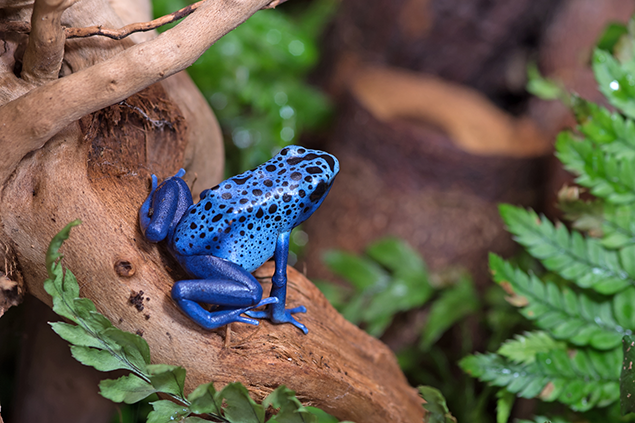Slice of Life
Tom Mazorlig //March 2, 2016//
 One of the niches within the reptile hobby is the design and maintenance of natural terrariums, also called vivariums. Natural terrarium aficionados seek to create tiny slices of rainforests or deserts in their homes.
One of the niches within the reptile hobby is the design and maintenance of natural terrariums, also called vivariums. Natural terrarium aficionados seek to create tiny slices of rainforests or deserts in their homes.
While there is no reliable information on how large this segment of the hobby is, some experts think the trend is growing.
“I have been seeing an increase in people designing natural terrariums,” said Ron Tremper, consulting herpetologist for Tetrafauna, Spectrum Brands and Pet, Home and Garden. “Why? First, there are better designed units available, like the ReptoHabitat that affords people the chance to keep plants and herps in harmony. Second, people want more out of their reptile pet and so a beautiful terrarium gets invited into the living or family room in more and more households.”
Mike Rizzo, owner of Glass Box Tropicals, a Michigan-based supplier of terrarium equipment, plants and poison dart frogs, agrees that popularity of keeping natural terrariums is growing. He sees different but related reasons for the growth.
“Yes, the keeping of naturalistic terrariums/vivariums is growing in popularity quite dramatically,” Rizzo said.
He believes there are three factors feeding this trend.
“One is social media,” Rizzo said. “There are now many Facebook groups as well as online forums devoted solely to this topic, many of them with thousands of members. When a member of one of these groups shares a picture or post, it allows an even larger audience to be exposed to the beauty and tranquility that these creations can bring to a home or office.”
“The second factor is education,” he said. “Many more hobbyists are learning that their animals will be happiest in a naturalistic setup. These setups help increase humidity and create more potential hiding spots, which often makes the animals inside feel more comfortable and secure.”
“Finally, there is increasing availability of the items needed to create amazing, naturalistic tanks,” Rizzo said. “There are several very popular and well-stocked websites, most that can have any item to you within days of ordering it, and many that also guarantee live arrival or plants and microfauna. Many brick and mortar pet stores are starting to carry additional naturalistic terrarium products as well.”
Lighten Up
Natural terrariums encompass diverse environments from rainforests to deserts to almost anything in between. One thing they have in common is live plants, and live plants need appropriate lighting.
“LED lighting has become an important part of natural terrariums for supporting plant growth and reptiles’ proper vision,” said Ashley Rademacher, animal care and education coordinator at Zoo Med. “Zoo Med’s new energy efficient LED Terrarium Lighting with a low profile design also boasts a unique modular design that allows for replacing or swapping out LED modules. Each module comes standard with three different colored light emitting diodes (LEDs) including white, red and blue. The 6500K daylight high output LEDs provide truly naturalistic, brilliant white lighting. This light supports pet’s vision and promotes natural behaviors such as feeding and breeding responses. Light combinations can be easily controlled with independent rocker switches located on the end of each hood.”
For terrarium inhabitants that need UVB lighting, Zoo Med offers the ReptiSun LED UVB Terrarium Hood. It combines the energy efficient ReptiSun LED lighting with a ReptiSun 5.0 UVB Lamp.
Enclosing Nature
While keepers can create a vivarium in any tank, most prefer front-opening terrariums for easier access.
The Tetrafauna brand from Spectrum Brands offers several enclosures that will fit the bill. The Deluxe ReptoHabitats come in several sizes and have sliding glass front doors along with sturdy screen tops, allowing easy access to any part of the terrarium. The bottom features a low profile drain to make cleaning out water features simple.
Zoo Med’s new Skyscraper Terrarium is an option for keeps of tree-dwelling species. It has an 18-inch by 18-inch base and is 36 inches tall.
“It is perfect for many arboreal species such as tree pythons and boas, New Caledonian geckos, anoles and many others,” Rademacher said. “The extra tall habitat allows arboreal animals to perform natural behaviors and feel secure in their tree-top home. The watertight base allows keepers to build naturalist habitats including water features and plants.”
Show Them How It’s Done
When it comes to natural terrariums, the best way for retailers to create interest– and sales–is to have one or more on display, according to experts.
“Seeing is believing,” Tremper said. “Retailers must have one or two knockout terrarium set-ups on display. This helps potential customers envision what could be theirs; especially if a recirculating waterfall is in play. The sales force must engage customers and show them the features and how to be successful.”
Rizzo agrees.
“The best way to sell many of these is to set up a nice display tank so that customers can envision the possibilities,” Rizzo said. “Some stores also have great success selling tanks that are already setup and ready for animals to be introduced immediately.”
According to Rademacher, it is helpful to show products in use.
“Showing products in use is really a great way to inspire current and potential pet keepers to be creative and build natural terrariums for their animals,” she said. “Zoo Med has made several different YouTube videos with examples of how to use products to create naturalistic terrariums. Retailers are always welcome to share our videos as well as photos from our website for inspiration and guidance.”



















